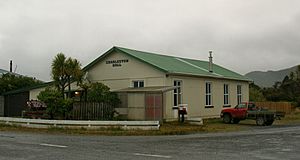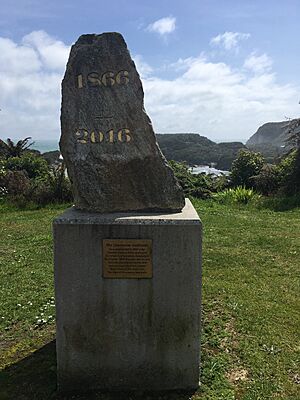Charleston, New Zealand facts for kids
Quick facts for kids
Charleston
|
|
|---|---|

The Charleston Goldfields Public Hall
|
|
| Country | New Zealand |
| Region | West Coast |
| District | Buller District |
| Ward | Westport |
| Electorates |
|
Charleston is a small village in the South Island of New Zealand. It is located about 30 kilometers south of Westport. Charleston began as a busy gold mining town after a big gold rush in 1867. Today, it is a popular spot for adventure tourists. People come here to explore its amazing caves and enjoy caving experiences. You can take guided tours of the nearby Metro Cave / Te Ananui Cave. These tours often travel up the Waitakere / Nile River valley.
A Golden Past: Charleston's History
Charleston's story started with a gold prospector named William Fox. He was born in Ireland around 1826. As a young man, he worked as a sailor before becoming a gold prospector.
In 1862, Bill Fox's search for gold in the Arrow district caused a lot of excitement. He traveled to New Zealand's West Coast in 1864. He looked for gold everywhere and first found it at Fox Creek in January 1865. This creek is a branch of the Arahura River, behind Hokitika.
According to a local historian, Les Wright, Fox organized a trip in July 1866. They went to what is now called Fox River. They did not find gold there. He then led his group about 20 kilometers north to where Charleston is today. They found gold in the sand, but it was too fine to collect easily. So, Fox went south to Ōkārito to learn how miners there were getting gold from fine sand.
While Fox was away in August 1866, others claimed credit for the Pakihi ('Parkeese') goldfield. This area later became known as the Charleston field. At first, supplies for 'Parkeese' were brought to Woodpecker Bay. This bay is south of Fox River. Workers then carried the goods about 20 kilometers north to the goldfield. Later, Captain Charles Bonner managed to bring his small ship, the 'Constant', into a tiny bay. This bay was near 'Parkeese'. The town that grew around this new landing spot was named Charleston. It was likely named in his honor. Some say the community was first called 'Charlie's Town', then 'Charles Town', before its current name. Unlike the famous city in America, Charleston, South Carolina, this town's name has three syllables.
In November 1866, Fox found a lot of gold at Brighton. This place is now called Tiromoana, about 16 kilometers south of Charleston. In May 1867, a discovery near Charleston itself started the last big 'gold rush' on the West Coast. Brighton was a larger town at first, but Charleston lasted longer. The two towns are sometimes confused in old records. In 1867, Brighton had 53 hotels, while Charleston had 37. However, between 1975 and 1979, people found remains of about 99 hotels in the Charleston area. The European Hotel was the last one standing. It was taken down after the 100-year celebrations around 1968. Hannahs shoe shop chain opened its very first store in Charleston in 1867. Mary's Hotel, at the south end of the nine-mile beach north of Charleston, was seen as the gateway to Charleston. It was also removed around 1970.
After gold mining slowed down, open-pit coal mines took over in Charleston. The Mowarts mine and later the McGlockland mine supplied coal to nearby Westport. Gold was still mined on the south end of the nine-mile beach until the late 1970s.
In the 1990s, seals from Cape Foulwind, near Westport, moved south to the Charleston coast. They made a home at the mouth of Bromielaw Creek. This is about 2 kilometers south of Constant Bay. Three shipwrecks have been found near Constant Bay and its neighbor, Joyce Bay. These ships are thought to be from the gold rush era.
Charleston was home to New Zealand's first cement buildings. These included a butter factory and a small house. The house still stands about 3 kilometers south of Charleston, near Cake Hill. The Waitakere / Nile River still has the cement walls of an old swing bridge. This bridge was part of the main road through the coast in 1899. Charleston is full of old gold workings. You should watch out for hidden old mining shafts in the area. Charleston also has coal, clay, and sandstone deposits. All of these have been mined over the years. The postmaster from Wellington even got a promotion to the Charleston Post Office in 1867. This was a big career step at the time.
The Charleston school building was moved to the Westport South School. The old school teacher's house is still there. It also served as the Charleston Police Station and jail before that.
The population of Charleston during the gold rush is often exaggerated. Some stories say 30,000 or even 100,000 people lived there. However, at the peak of the gold rush, the entire West Coast probably had only 35,000 people. A census in early 1867, during the busiest time of the Charleston rush, showed about 5,000 people on the Charleston field. Another 6,000 were on the Brighton field, ten miles to the south.
Explore Nature: Caves and Rivers
The Waitakere or Nile River flows out just north of Charleston. This area is full of amazing limestone cliffs and caves. You can take exciting cave and rafting tours from Charleston into the Nile River valley. These tours sometimes include a short ride on a bush tram track.
The Fox River, about 30 kilometers south of Charleston, is named after William Fox. He was the gold prospector who helped start Charleston.
Charleston Today: Population and Community
The Charleston area covers about 1,015 square kilometers. As of 2023, it has an estimated population of around 500 people. This means there are about 0.5 people per square kilometer.
| Historical population for the statistical area | ||
|---|---|---|
| Year | Pop. | ±% p.a. |
| 2006 | 516 | — |
| 2013 | 657 | +3.51% |
| 2018 | 522 | −4.50% |
The population of the Charleston area was 522 people at the 2018 New Zealand census. This was a decrease of 135 people since the 2013 census. However, it was a small increase of 6 people since the 2006 census. There were 225 households in the area. The median age was 48.7 years. About 14.4% of the people were under 15 years old.
Most people in Charleston are of European descent (93.1%). Some people also identify as Māori (8.6%). About 15.5% of the people were born outside New Zealand.
When asked about their beliefs, 56.3% of people said they had no religion. About 29.9% were Christian.
For those aged 15 and older, 17.4% had a university degree or higher. The average income was $26,500. About 50.3% of people aged 15 and over worked full-time.



